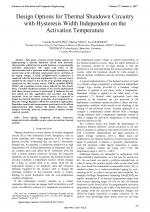| 1/2017 - 10 |
Design Options for Thermal Shutdown Circuitry with Hysteresis Width Independent on the Activation TemperaturePLESA, C.-S. |
| Extra paper information in |
| Click to see author's profile in |
| Download PDF |
Author keywords
bipolar integrated circuits, hysteresis, integrated circuit reliability, power system protection, thermal analysis
References keywords
thermal(7), circuit(6), protection(5), voltage(4), test(4), power(4), current(4)
Blue keywords are present in both the references section and the paper title.
About this article
Date of Publication: 2017-02-28
Volume 17, Issue 1, Year 2017, On page(s): 69 - 74
ISSN: 1582-7445, e-ISSN: 1844-7600
Digital Object Identifier: 10.4316/AECE.2017.01010
Web of Science Accession Number: 000396335900010
SCOPUS ID: 85014193533
Abstract
This paper presents several design options for implementing a thermal shutdown circuit with hysteretic characteristic, which has two special features: a programmable activation temperature (the upper trip point of the characteristic) and a hysteresis width largely insensitive to the actual value of the activation temperature and to variations of the supply voltage. A fairly straightforward architecture is employed, with the hysteresis implemented by a current source enabled by the output of the circuit. Four possible designs are considered for this current source: VBE/R, modified-VBE/R, Widlar and a peaking current source tailored for this circuit. First, a detailed analytical analysis of the circuit implemented with these current sources is performed; it indicates the one best suited for this application and provides key sizing equations. Next, the chosen current source is employed to design the thermal shutdown protection of an integrated Low-Dropout Voltage Regulator (LDO) for automotive applications. Simulation results and measurements performed on the silicon implementation fully validate the design. Moreover, they compare favorably with the performance of similar circuits reported recently. |
| References | | | Cited By |
Web of Science® Times Cited: 6 [View]
View record in Web of Science® [View]
View Related Records® [View]
Updated today
SCOPUS® Times Cited: 6
View record in SCOPUS® [Free preview]
View citations in SCOPUS® [Free preview]
[1] Design Options for Current Limit and Power Limit Circuit Protections for LDOs, PLESA, C.-S., DIMITRIU, B., NEAG, M., Advances in Electrical and Computer Engineering, ISSN 1582-7445, Issue 1, Volume 19, 2019.
Digital Object Identifier: 10.4316/AECE.2019.01008 [CrossRef] [Full text]
[2] Design methodology for over-temperature and over-current protection of an LDO voltage regulator by using electro-thermal simulations, Plesa, Cosmin-Sorin, Neag, Marius, Boianceanu, Cristian, Negoita, Andrei, Microelectronics Reliability, ISSN 0026-2714, Issue , 2017.
Digital Object Identifier: 10.1016/j.microrel.2017.03.028 [CrossRef]
[3] Over-Temperature Protection for a Switched-Capacitor DC-DC Converter with Controlled Charging Current, Plesa, Cosmin-Sorin, Neag, Marius, Boianceanu, Cristian Mihai, 2018 International Semiconductor Conference (CAS), ISBN 978-1-5386-4482-9, 2018.
Digital Object Identifier: 10.1109/SMICND.2018.8539822 [CrossRef]
Disclaimer: All information displayed above was retrieved by using remote connections to respective databases. For the best user experience, we update all data by using background processes, and use caches in order to reduce the load on the servers we retrieve the information from. As we have no control on the availability of the database servers and sometimes the Internet connectivity may be affected, we do not guarantee the information is correct or complete. For the most accurate data, please always consult the database sites directly. Some external links require authentication or an institutional subscription.
Web of Science® is a registered trademark of Clarivate Analytics, Scopus® is a registered trademark of Elsevier B.V., other product names, company names, brand names, trademarks and logos are the property of their respective owners.
Faculty of Electrical Engineering and Computer Science
Stefan cel Mare University of Suceava, Romania
All rights reserved: Advances in Electrical and Computer Engineering is a registered trademark of the Stefan cel Mare University of Suceava. No part of this publication may be reproduced, stored in a retrieval system, photocopied, recorded or archived, without the written permission from the Editor. When authors submit their papers for publication, they agree that the copyright for their article be transferred to the Faculty of Electrical Engineering and Computer Science, Stefan cel Mare University of Suceava, Romania, if and only if the articles are accepted for publication. The copyright covers the exclusive rights to reproduce and distribute the article, including reprints and translations.
Permission for other use: The copyright owner's consent does not extend to copying for general distribution, for promotion, for creating new works, or for resale. Specific written permission must be obtained from the Editor for such copying. Direct linking to files hosted on this website is strictly prohibited.
Disclaimer: Whilst every effort is made by the publishers and editorial board to see that no inaccurate or misleading data, opinions or statements appear in this journal, they wish to make it clear that all information and opinions formulated in the articles, as well as linguistic accuracy, are the sole responsibility of the author.



